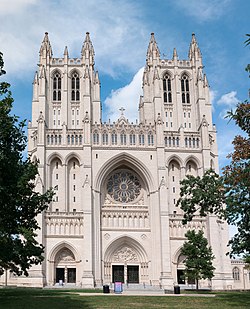Washington National Cathedral | |
 Washington National Cathedral is officially dedicated as the "Cathedral Church of Saint Peter and Saint Paul in the City and Diocese of Washington" | |
| Location | Wisconsin Avenue and Massachusetts Avenue, Northwest, Washington, D.C., United States |
|---|---|
| Coordinates | 38°55′50″N 77°4′15″W / 38.93056°N 77.07083°W |
| Built | 1906 to 1988 |
| Architect | George Frederick Bodley, Philip Hubert Frohman |
| Architectural style | Neo-Gothic |
| NRHP reference No. | 74002170 |
| Added to NRHP | May 3, 1974 |
 | |


The Cathedral Church of Saint Peter and Saint Paul in the City and Diocese of Washington, commonly known as Washington National Cathedral or National Cathedral, is an American cathedral of the Episcopal Church. The cathedral is located in Washington, D.C., the capital of the United States.[1][2] The structure is of Neo-Gothic design closely modeled on English Gothic style of the late fourteenth century. It is the second-largest church building in the United States,[3] and the third-tallest building in Washington, D.C. The cathedral is the seat of both the Presiding Bishop of the Episcopal Church, Sean Rowe, and the bishop of the Diocese of Washington, Mariann Edgar Budde. Over 270,000 people visit the structure annually.[4]
The Protestant Episcopal Cathedral Foundation, under the first seven Bishops of Washington, erected the cathedral under a charter passed by the United States Congress on January 6, 1893.[5] Construction began on September 29, 1907, when the foundation stone was laid in the presence of President Theodore Roosevelt and a crowd of more than 20,000, and ended 83 years later when the "final finial" was placed in the presence of President George H. W. Bush on September 29, 1990. Decorative and restorative work, particularly of damage from a nearby earthquake in 2011, is ongoing as of 2024.[update] The Foundation is the legal entity of which all institutions on the Cathedral Close are a part; its corporate staff provides services for the institutions to help enable their missions, conducts work of the Foundation itself that is not done by the other entities, and serves as staff for the board of trustees.
The cathedral stands at Massachusetts and Wisconsin Avenues in the northwest quadrant of Washington. It is an associate member of the recently organized inter-denominational Washington Theological Consortium.[6] It is listed on the National Register of Historic Places. In 2007, it was ranked third on the List of America's Favorite Architecture by the American Institute of Architects.[7]
- ^ Episcopal Church (1990). Consecration of the Cathedral Church of Saint Peter and Saint Paul in the City and Diocese of Washington: A Litany of Thanksgiving: Celebration of the Holy Eucharist ... : Sunday, September Thirtieth, Nineteen Hundred and Ninety, at Eleven O'clock. The Cathedral. Retrieved April 6, 2013.
- ^ The Episcopal Church Center (2011). "Cathedral Church of Saint Peter and Saint Paul in the City and Diocese of Washington". Retrieved April 6, 2013.
- ^ "Facts & Figures". Washington National Cathedral.
- ^ "Annual Report: Highlights". Washington National Cathedral. 2016. Retrieved April 23, 2018.
- ^ Quinn, Fredrick (October 1, 2014). A House of Prayer for All People: A History of Washington National Cathedral. Church Publishing, Inc. p. 3. ISBN 9780819229243.
The quest for a National Cathedral, the best-known endeavor of Satterlee's episcopate, had deep roots in American national life. Major Pierre L'Enfant envisioned "a great church for national purposes" in his original plans for the city of Washington, but nothing came of the idea. After several meetings of leading Washington figures, including planning sessions in the home of Charles C. Glover, president of the Riggs Bank, the Protestant Episcopal Church Foundation was created on January 6, 1893, by Act of Congress, signed by President Benjamin Harrison.
- ^ "Member Institutions". Washington Theological Consortium. Retrieved October 2, 2009.
- ^ Clark, Jayne (June 21, 2007). "National Cathedral Celebrates Its Centennial". USA Today. Archived from the original on November 6, 2018.

